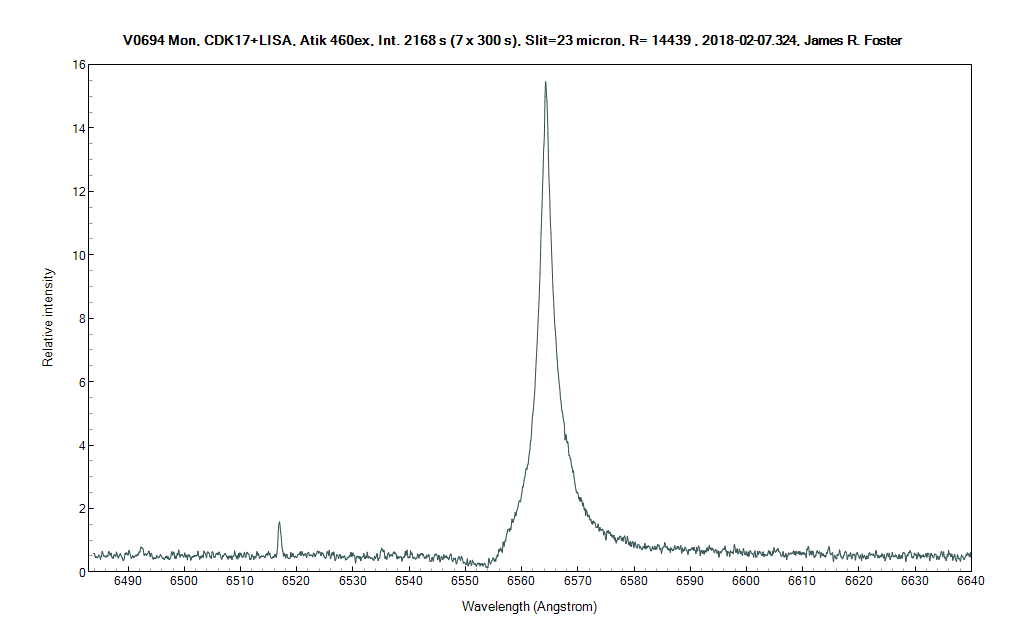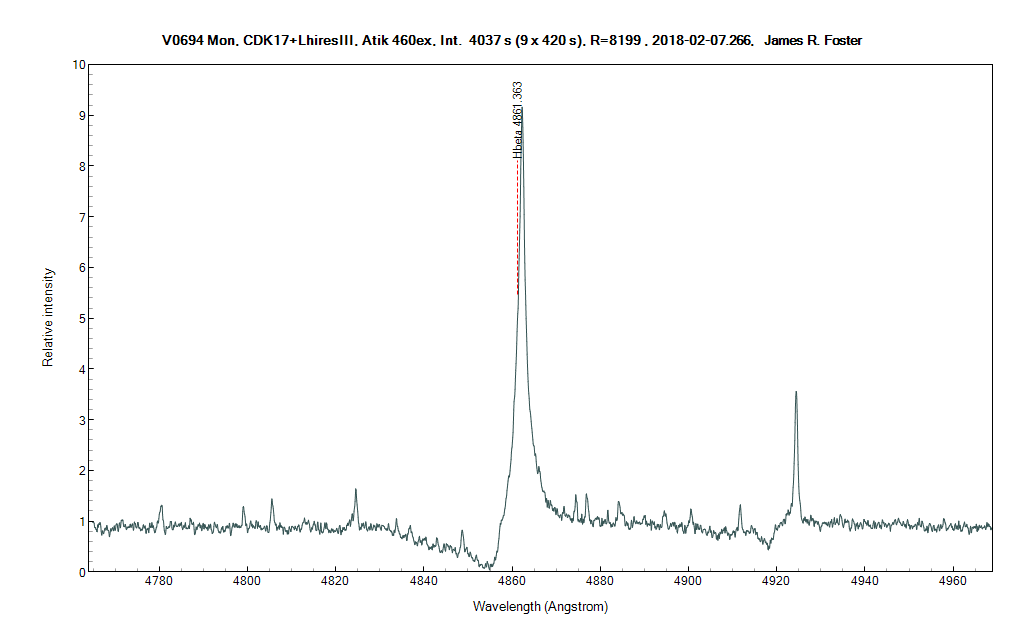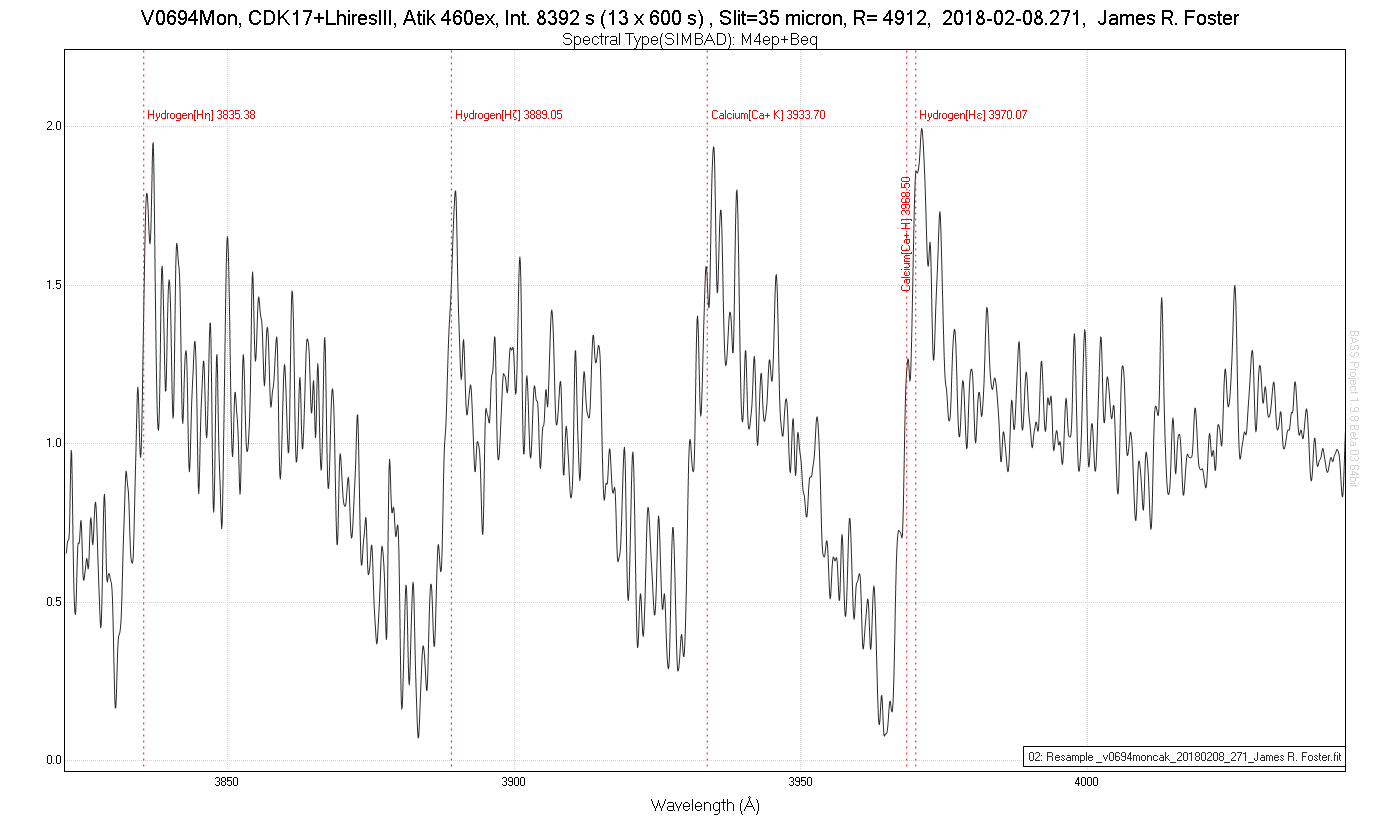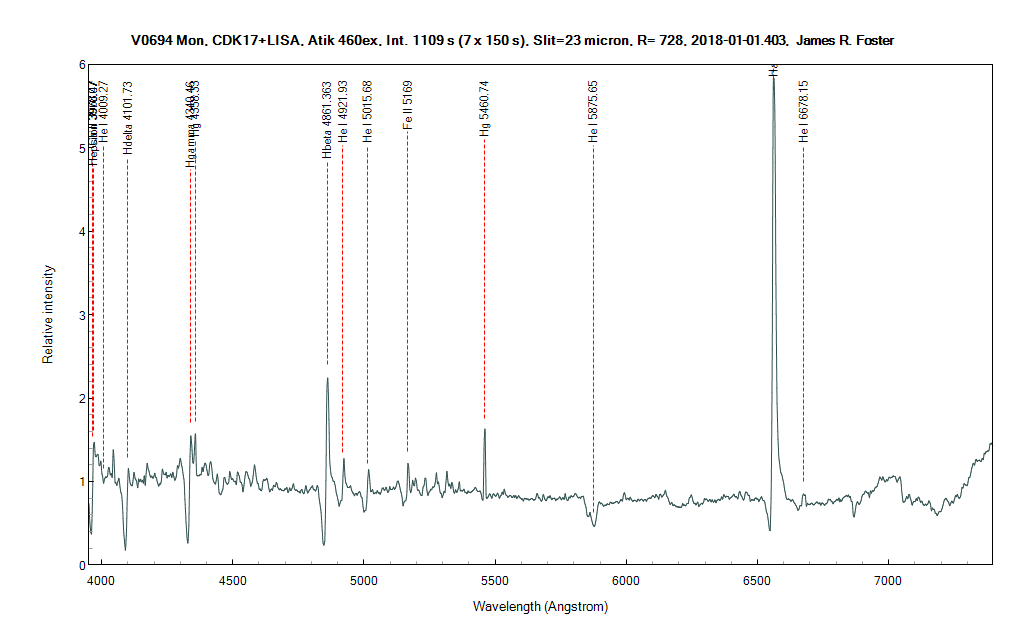V694 Mon revisted
-
Jim Ferreira
- Posts: 8
- Joined: Sun Jan 27, 2013 9:42 pm
V694 Mon revisted
Hello group
I recently recorded low resolution spectra for V694 Mon [MWC560] and as expected the H Balmer absorption troughs are narrower than in spectra recorded early last year, shortly after the major outburst. I have a basic understanding of how the absorption troughs relate to polar jet velocity, however, I am puzzled by the difference in the absorption troughs for Fe II 4924, 5018 and 5169 which are significantly larger now than those recorded 2016 April. Can anyone shed a little light on how the Fe II lines would be affected by the polar jet velocity, making the assumption that the Fe II lines have their origin in the accretion disk, and, what the difference in the Fe II absorption troughs may indicate?
Any input would be very much appreciated.
http://www.lafterhall.com/v0694-mon_201 ... ra_002.png
Starry Skies
Jim Ferreira
Livermore CA USA
I recently recorded low resolution spectra for V694 Mon [MWC560] and as expected the H Balmer absorption troughs are narrower than in spectra recorded early last year, shortly after the major outburst. I have a basic understanding of how the absorption troughs relate to polar jet velocity, however, I am puzzled by the difference in the absorption troughs for Fe II 4924, 5018 and 5169 which are significantly larger now than those recorded 2016 April. Can anyone shed a little light on how the Fe II lines would be affected by the polar jet velocity, making the assumption that the Fe II lines have their origin in the accretion disk, and, what the difference in the Fe II absorption troughs may indicate?
Any input would be very much appreciated.
http://www.lafterhall.com/v0694-mon_201 ... ra_002.png
Starry Skies
Jim Ferreira
Livermore CA USA
-
Francois Teyssier
- Posts: 1565
- Joined: Fri Sep 23, 2011 1:01 pm
- Location: Rouen
- Contact:
Re: V694 Mon revisted
Dear Jim,
Only the *emission* component of metal lines - Fe, Ti, Mg ... - have a low FWHM (about 20 km/s, 40 km/s with a broader pesdestrial for Fe II (42) multiplet) and are considered to be produced essentially in the accretion disk, the nebula anf jet near the hot component of the sytem.
The absorption is mainly produced in the jet itself
Here's for instance Fe II 6456 in a spectrum obtained last year
FWHM = 35 km/s
V694 Mon is highly variable, even from night to night. Accretion rate may be the origin of the variablity.
During the last optical outburst in 2016, an strong enhancement of the maximupm absorption velocity was expected, but ... didn't occured. V694 Mon is an "exotic" object.
In 2011, I got absorptions at more than -7000 km/s
http://www.astronomie-amateur.fr/feuill ... 94Mon.html
Your spectra are nice. Instrumental and atmospheric correction should be the next step.
All the best
François Teyssier
Only the *emission* component of metal lines - Fe, Ti, Mg ... - have a low FWHM (about 20 km/s, 40 km/s with a broader pesdestrial for Fe II (42) multiplet) and are considered to be produced essentially in the accretion disk, the nebula anf jet near the hot component of the sytem.
The absorption is mainly produced in the jet itself
Here's for instance Fe II 6456 in a spectrum obtained last year
FWHM = 35 km/s
V694 Mon is highly variable, even from night to night. Accretion rate may be the origin of the variablity.
During the last optical outburst in 2016, an strong enhancement of the maximupm absorption velocity was expected, but ... didn't occured. V694 Mon is an "exotic" object.
In 2011, I got absorptions at more than -7000 km/s
http://www.astronomie-amateur.fr/feuill ... 94Mon.html
Your spectra are nice. Instrumental and atmospheric correction should be the next step.
All the best
François Teyssier
François Teyssier
http://www.astronomie-amateur.fr
http://www.astronomie-amateur.fr
-
Jim Ferreira
- Posts: 8
- Joined: Sun Jan 27, 2013 9:42 pm
Re: V694 Mon revisted
Thank you, Francois, for the clarification on the Fe II absorption trough differences. Patiently waiting for clear skies here in 'sunny' California. Should night skies ever clear, I intend to record a series of spectra to look for short period variations in the Fe II absorption. A project, it would seem, well within the capability of the Alpy 600. Again, thank you for the information and encouragement.
Starry Nights!
Jim Ferreira
Livermore ca
http://www.lafterhall.com/spectroscopy_ ... graph.html
Starry Nights!
Jim Ferreira
Livermore ca
http://www.lafterhall.com/spectroscopy_ ... graph.html
-
Francois Teyssier
- Posts: 1565
- Joined: Fri Sep 23, 2011 1:01 pm
- Location: Rouen
- Contact:
Re: V694 Mon revisted
Following new questions, here's a model adapted from Schmid & al.
See also Shore & al. 1994, Tomov, 1992, 1997
The wind from the red giant (sollar type matter) forms an accretion disk around the magnetic white dwarf of low luminosity
The magnetic field acts as an propeller to form the jet
The boundary layer, the viscosity of the disk heat the upper layers of the disk at about 20 000 K which provoques ionisation (low ) of H and metals, essentially one time ionised
The narrow emission lines of hydrogen and ionised metals (Fe II, Ti II, Cr II, Si II ..) are emitted from a large part of the disk. These are narrow lines. From a spectrum obtained two days ago, I get FWHM of 30-35 km/s for most of the lines. Only Fe II 42 multiplet gives broader lines (50 km/s).
The jets is formed by the solar ionised matter (at least at the begining). The recombination time is long.
So the ions can absorbe the photons of the continuum at the blue shift wavelenght produced by their velocity. This is the reason why the absortions are much wider than the emission. They are not formed in the some region of the sytem.
For Fe II (42) about 25% of the photons of the continuum are absorbed. While HI can absorbed about 75% of the photons due to its higher column density.
Here's the measures of a few lines that I obtained with the excellent Tim Lester's PlotSpectra All the best,
François
See also Shore & al. 1994, Tomov, 1992, 1997
The wind from the red giant (sollar type matter) forms an accretion disk around the magnetic white dwarf of low luminosity
The magnetic field acts as an propeller to form the jet
The boundary layer, the viscosity of the disk heat the upper layers of the disk at about 20 000 K which provoques ionisation (low ) of H and metals, essentially one time ionised
The narrow emission lines of hydrogen and ionised metals (Fe II, Ti II, Cr II, Si II ..) are emitted from a large part of the disk. These are narrow lines. From a spectrum obtained two days ago, I get FWHM of 30-35 km/s for most of the lines. Only Fe II 42 multiplet gives broader lines (50 km/s).
The jets is formed by the solar ionised matter (at least at the begining). The recombination time is long.
So the ions can absorbe the photons of the continuum at the blue shift wavelenght produced by their velocity. This is the reason why the absortions are much wider than the emission. They are not formed in the some region of the sytem.
For Fe II (42) about 25% of the photons of the continuum are absorbed. While HI can absorbed about 75% of the photons due to its higher column density.
Here's the measures of a few lines that I obtained with the excellent Tim Lester's PlotSpectra All the best,
François
François Teyssier
http://www.astronomie-amateur.fr
http://www.astronomie-amateur.fr
-
Joan Guarro Flo
- Posts: 716
- Joined: Thu Nov 03, 2011 8:50 pm
Re: V694 Mon revisted
Hi,
This is a new spectra of V694 Mon.
Cheers, Joan.
This is a new spectra of V694 Mon.
Cheers, Joan.
- Attachments
-
- _v694mon_20170407_848_J. Guarro.png (7.17 KiB) Viewed 16121 times
Re: V694 Mon revisted
My first attempt at V694 Mon. 9 x 300 s
Looks like the Red Giant is showing itself (or my instrumental response isn't so good; C Hydrae is the reference)
The broad absorptions seem to get narrower with increasing wavelength. Is that because shorter wavelengths are produced near the center of the disk,which results in more coverage by the jet = more dispersion of velocities?
Does the Red Giant account, in part, for the small H-alpha absorption?
Thanks.
---------------------------------
Mon premier essai avec V694 Mon. 9 x 300 s
On dirait que la Géante Rouge se laisse voir (ou peut-être ma réponse instrumentale n'est pas bonne, j'ai choisi C Hydrae comme référence)
Il y a beaucoup de choses à observer et à comprendre. Beaucoup de questions. Merci Francois pour le dessin.
Looks like the Red Giant is showing itself (or my instrumental response isn't so good; C Hydrae is the reference)
The broad absorptions seem to get narrower with increasing wavelength. Is that because shorter wavelengths are produced near the center of the disk,which results in more coverage by the jet = more dispersion of velocities?
Does the Red Giant account, in part, for the small H-alpha absorption?
Thanks.
---------------------------------
Mon premier essai avec V694 Mon. 9 x 300 s
On dirait que la Géante Rouge se laisse voir (ou peut-être ma réponse instrumentale n'est pas bonne, j'ai choisi C Hydrae comme référence)
Il y a beaucoup de choses à observer et à comprendre. Beaucoup de questions. Merci Francois pour le dessin.
Shelyak Alpy 600 (spectroscope, guiding module and calibration module) | GSO 8" f/4 | Orion Atlas Pro | ZWO ASI178MM-Cool (mono) | ZWO ASI290 Mini (mono)
"think like a photon" -- Steve Shore
"think like a photon" -- Steve Shore
-
Francois Teyssier
- Posts: 1565
- Joined: Fri Sep 23, 2011 1:01 pm
- Location: Rouen
- Contact:
Re: V694 Mon revisted
Bonjour James,
Le spectre est très bon au niveau de la résolution.
Effectivement, la correction atmosphérique n'est pas bonne. Voir les derniers spectres obtenus par David et Woody:http://www.astrosurf.com/aras/Aras_Data ... 694Mon.htm
pas facile de trouver une bonne étoile de référence dans cette région
del Mon est brillante, mais un peu trop haute. Son spectre peut être obtenu avant V694 Mon de façon à faire coïncider les hauteurs
voir aussi HD 49147 Bonne continuation
François
Le spectre est très bon au niveau de la résolution.
Effectivement, la correction atmosphérique n'est pas bonne. Voir les derniers spectres obtenus par David et Woody:http://www.astrosurf.com/aras/Aras_Data ... 694Mon.htm
pas facile de trouver une bonne étoile de référence dans cette région
del Mon est brillante, mais un peu trop haute. Son spectre peut être obtenu avant V694 Mon de façon à faire coïncider les hauteurs
voir aussi HD 49147 Bonne continuation
François
François Teyssier
http://www.astronomie-amateur.fr
http://www.astronomie-amateur.fr
-
etienne bertrand
- Posts: 1041
- Joined: Mon Aug 31, 2015 11:26 am
Re: V694 Mon revisted
Merci pour le schema explicatif c'est top !
-
James Foster
- Posts: 456
- Joined: Sun Jan 24, 2016 7:14 am
Re: V694 Mon revisted
Thanks to Francois Teyssier for the beautiful graphic on this interacting symbiotic!
Here is my LhiresIII (Ha, Hb, & Cak 7/8Feb18) and (older) LISA spectra for V0694 Mon:
LhiresIII:



LISA (01Jan18):

I had to apply a low-pass Gausian to my LhiresIII CaK data because of the faintness of the Spectra in this band even after exposing over 2 Hrs!
I used HD071155 for my Ha/Hb IRC star on 07Feb18and HD045067 for my IRC star for the Cak data on 08Feb18; both around 0 deg declination.
James
Here is my LhiresIII (Ha, Hb, & Cak 7/8Feb18) and (older) LISA spectra for V0694 Mon:
LhiresIII:



LISA (01Jan18):

I had to apply a low-pass Gausian to my LhiresIII CaK data because of the faintness of the Spectra in this band even after exposing over 2 Hrs!
I used HD071155 for my Ha/Hb IRC star on 07Feb18and HD045067 for my IRC star for the Cak data on 08Feb18; both around 0 deg declination.
James
James Foster
eShel2-Zwo ASI2600MM Pro
Lhires III (2400/1800/600 ln/mm Grat) Spectroscope
LISA IR/Visual Spectroscope (IR Configured)
Alpy 200/600 with Guide/Calibration modules and Photometric slit
Star Analyzer 200
eShel2-Zwo ASI2600MM Pro
Lhires III (2400/1800/600 ln/mm Grat) Spectroscope
LISA IR/Visual Spectroscope (IR Configured)
Alpy 200/600 with Guide/Calibration modules and Photometric slit
Star Analyzer 200
Re: V694 Mon revisted
Merci François. Le spreadsheet ReferenceStarFinder sera très util. Je n'ai pas traité ce specturm avec ISIS et je pense que la réponse instrumentale n'était pas correcte. J'ai essayé encore et bien que la réponse soit meilleure, je ne pense pas que cela corresponde parfaitement à la référence A0V. Je vais essayer à nouveau avec ISIS et choisir une autre étoile la prochaine fois.Francois Teyssier wrote:Bonjour James,
Le spectre est très bon au niveau de la résolution.
Effectivement, la correction atmosphérique n'est pas bonne. Voir les derniers spectres obtenus par David et Woody:http://www.astrosurf.com/aras/Aras_Data ... 694Mon.htm
pas facile de trouver une bonne étoile de référence dans cette région
del Mon est brillante, mais un peu trop haute. Son spectre peut être obtenu avant V694 Mon de façon à faire coïncider les hauteurs
voir aussi HD 49147 Bonne continuation
François
Shelyak Alpy 600 (spectroscope, guiding module and calibration module) | GSO 8" f/4 | Orion Atlas Pro | ZWO ASI178MM-Cool (mono) | ZWO ASI290 Mini (mono)
"think like a photon" -- Steve Shore
"think like a photon" -- Steve Shore